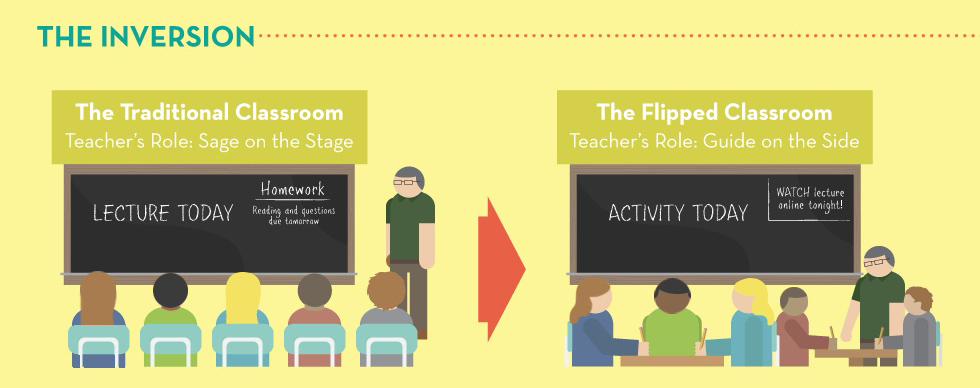 by: Linda Dunnavant
by: Linda Dunnavant
What is the “flipped classroom”?
If you are an educator, chances are you’ve heard the phrase “flipping the classroom” being thrown around. We know that trends come and go in education about as often as front runners for the Republican presidential nomination. While I think we should be wary of jumping onto every pedagogical bandwagon that comes along, it is becoming clear that flipping the classroom is a worthwhile idea with staying power.
Flipping the classroom is, in a nutshell, introducing students to course concepts at home so that class time can be utilized for active learning. By giving students access to course content at home, valuable class time can be spent applying concepts, asking questions, collaborating, discussing, and participating in other active learning activities. In the flipped classroom, students are asked to view short lessons at home so they come to class armed with the background content they need to be able to engage with the material in a real way. The teacher is no longer the “sage on the stage” who holds all the knowledge. Instead, he or she gives students access to the knowledge via short, easily digestible videos that students can watch on their own time. This gives the teacher the freedom to use class time in more meaningful ways, including more time to provide small group and individualized instruction for students who need it.

see below for full infographic
(see full infographic below)
Instruction is inherently differentiated in the flipped classroom because students can access the content at their own pace. For example, if you are teaching a lesson on friction, students who already understand the concept can quickly review a video lesson as a refresher. The majority of students can watch the lesson in real time and pause to reflect if needed. Students completely unfamiliar with the concept—or students who need additional processing time—can start and stop the video as needed and learn at their own speed. These same students can then spend class time working in small groups investigating how friction works, asking questions, discussing the concept, and participating in other various hands-on activities.
Watch this short video to see this process illustrated.
Why flip the science classroom, specifically?
Flipped classroom expert Jonathan Bergmann encourages teachers to begin by asking themselves the question, “What is the best use of your face-to-face class time?” I think most of us would agree with the National Science Teachers Association: it’s best for students to spend the majority of class time “actually doing science—so students spend more time posing questions and discovering the answers for themselves.” Flipping the classroom is a strategy that teachers can use to help make this vision a reality.
Science teachers are asked to cover loads of content over the course of the school year. Especially with changing standards and the push to incorporate 21st Century skills into the curriculum, science teachers have more on their plates than ever before. Also, what science teacher hasn’t had to deal with the headache of catching up students who were absent and missed a key lecture? Perhaps most importantly, in the flipped classroom, the teacher doesn’t have to spend class time lecturing, so time is freed up for students to do the real work that scientists do.
How do you implement it?
- Start small. Don’t try to flip your entire classroom all at once. Instead, pick a unit or series of lessons to flip in a content area that you feel very knowledgeable in.
- Before getting started, make sure all students have access to technology at home. We know that most of our students out there at least have access to a smart phone, but if not, here is a great suggestion from Erin Klein about setting up digital workstations in the classroom. She calls her method “internal flipping” because her students watch the videos in class instead of at home.
- Figure out how to present lessons to students using technology that students can access at home. You can create original videos or podcasts, or you can find and use ready-made resources online. Here’s a short list of resources to get you started.
- Knowmia – Knowmia has a database of great short lessons created by teachers on a variety of subjects. Their iPad app also allows you to create and upload your own lessons. It also has other great features such as an assignment wizard tool that helps you track student progress in real time.
- Khan Academy – Khan Academy is a phenomenal resource for ready-made videos on a variety of topics, specifically science concepts. The videos are short, easily digestible, and well made. This is a great option for teachers who are unsure of how to create and upload videos, but still want to try their hand at flipping the classroom.
- 100 Incredible Science Lectures for the Flipped Classroom – This blog post from teachthought.com provides a wealth of video resources for science teachers to use with students. These lessons appear to be better suited to secondary students.
- Above all, remember that flipping the classroom does not just mean giving students access to video lectures at home. Classroom teaching has to be transformed to make students active participants in their learning. We as teachers know what good and bad instruction looks like. We know that it’s ineffective to stand in front of our students and lecture all day. We also know that we need time to work with students individually and in small groups. Flipping the classroom helps set up instruction in a way that teachers are freed up to do all those things we know that we need to be doing.
Do you have experience with flipping the classroom? We’d love to hear about it!
Click twice on the infographic below for a full-size image.
(Image source: http://www.knewton.com/blog/
education-infographics/flipped-classroom-infographic)
Linda Dunnavant is a middle school teacher whose blog, “Tales of a Fifth Grade Teacher,” can be accessed here.
